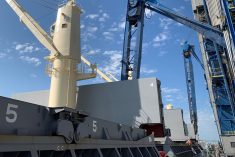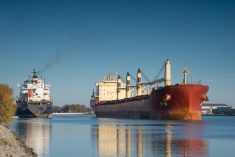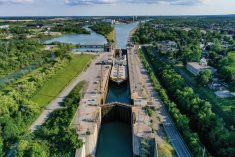The first of CWB’s new laker vessels marked the official opening of the St. Lawrence Seaway for 2015 on Thursday, passing through the South Shore Canal’s St. Lambert Lock near Montreal.
The seaway navigation season’s official opening had previously been set for March 27, but officials opted in early March to put off the opening to Thursday, given factors such as ice conditions “affecting safe navigation and effective system transit.”
The CWB Marquis, operated by Algoma Central Corp. on the former Canadian Wheat Board’s behalf, is the first of two Equinox-class lakers CWB ordered “purpose-built” for seaway travel, a total investment valued at about $65 million when announced in 2011.
Read Also

Huge crops in South America says analyst
Although there’s a debate over the size of the South American soybean crop, there’s little doubt that it will be an enormous one, said consultant Michael Cordonnier of Soybean and Corn Advisor in Hinsdale, Ill.
Seaway officials noted Thursday that various Great Lakes/Seaway carriers have budgeted about $4 billion for a 10-year fleet renewal plan between 2009 and 2018, CWB’s boats included.
The St. Lawrence Seaway Management Corp. (SLSMC) said Thursday it’s also in the midst of a $5 billion five-year plan to modernize the seaway’s locks and other infrastructure, while the U.S. St. Lawrence Seaway Development Corp. has budgeted $99 million for asset renewal over the same period.
Transport Canada said Thursday it has pledged over $4 billion for projects in Quebec and Ontario “to help create competitive transportation systems that support Canada’s trade initiatives.”
Among those projects, federal Transport Minister Lisa Raitt said in a separate release Thursday the government “will continue to invest in the seaway, to help us build and maintain a strong, competitive, safe and secure marine transportation system for Canada.”
CWB’s laker investment “underlines the importance of the St. Lawrence Seaway to Canada’s agricultural industry,” SLSMC CEO Terence Bowles said in the corporation’s release.
“As agricultural technology boosts production and global demand for grain intensifies, there is great opportunity for the Seaway to be increasingly at the center of Canadian and U.S. efforts to broaden exports.”
“Blowout volume”
“The future success of our company is dependent on reliable, cost-effective transportation networks going east, as well as west,” CWB CEO Ian White, the event’s keynote speaker, said in the same release.
“Our new vessels, along with our terminals in Thunder Bay and Trois-Rivieres, will allow us to reach our customers in Europe, the Middle East and Africa quickly and, at the same time, get the best returns for farmers.”
CWB has directly owned shore space on the Great Lakes and Seaway since 2013, when it bought the grain handling and port terminal assets of Upper Lakes Group’s Soumat arm, including Thunder Bay’s Mission Terminal facility and Les Elevateurs des Trois-Rivieres.
According to Transport Canada, the seaway in 2014 booked its best annual grain handle in the 21st century to date, at over 12 million tonnes.
Bowles, speaking of the volume outlook across all commodities for 2015, said he hopes for a repeat of the “strong results” seen in 2014, when the seaway handled 40 million tonnes of cargo.
“Tonnage forecasts are always difficult, especially with continued volatility in the global economy,” he said.
Seaway officials said in January that the overall cargo levels in 2014 were up seven per cent from 2013 levels, due mainly to a “blowout volume” of grain pushed through the seaway as merchants sought to move the backed-up 2013 bumper crop. — AGCanada.com Network














